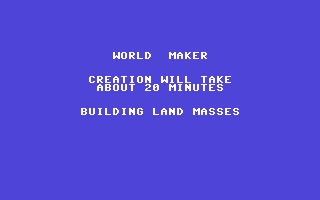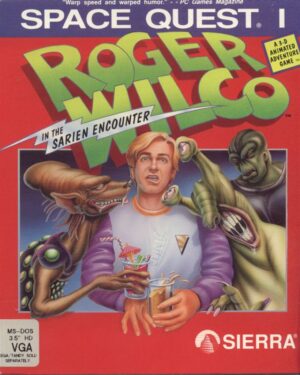Retro Replay Review
Gameplay
The Seven Cities of Gold places you in the boots of Christopher Columbus and later Spanish conquistadors, tasking you with exploring both a historically accurate map of the New World circa 1492 and a variety of randomized worlds. You set up forts, establish missions, and manage resources such as food, supplies, and gold shipments bound for Spain. Each voyage offers a delicate balance between risk and reward: push further into unknown territories for richer finds or consolidate your holdings to maintain supplies and morale.
(HEY YOU!! We hope you enjoy! We try not to run ads. So basically, this is a very expensive hobby running this site. Please consider joining us for updates, forums, and more. Network w/ us to make some cash or friends while retro gaming, and you can win some free retro games for posting. Okay, carry on 👍)
One of the game’s most engaging mechanics is its arcade‐style interaction sequences, which stand in for the language barrier between Spaniard and Native. These mini‐games test your reflexes and decision‐making under pressure—decide whether to offer gifts of beads and trinkets or brandish weapons to secure gold through intimidation. Such sequences bring a pulse of immediacy to an otherwise methodical exploration experience.
Beyond scripted historical scenarios, the randomly generated maps inject nearly endless replayability. Every new game reshuffles coastlines, rivers, and native settlements, forcing you to adapt your strategy. You’ll need to scout for friendly tribes willing to trade, choose when to found missions or build forts, and determine the optimal route back to Europe to maximize your profit and earn the Queen’s favor.
Graphics
Though The Seven Cities of Gold debuted in the mid‐1980s, its graphical presentation remains surprisingly evocative. The world map uses a simple yet effective color palette to differentiate terrain types such as jungles, mountains, and rivers. Iconic sprites represent your ships, forts, and missions, while native villages and wildlife are rendered with just enough detail to give each expedition a sense of discovery.
The interface itself is clean and functional, with clear text menus for issuing orders, viewing inventories, and monitoring crew morale. When you enter one of the arcade sequences, the screen shifts to a more vibrant display, underscoring the tense negotiations with native tribes. These graphical transitions help break up the map‐based gameplay and add variety to each play session.
On modern hardware or through emulation, the visuals can be scaled up without significant loss of fidelity, making it easy for new players to appreciate the sprawling New World in all its pixelated glory. While you won’t find photo‐realistic jungles or dynamic weather effects, the minimalist artistry perfectly suits the game’s blend of strategy and exploration.
Story
The Seven Cities of Gold weaves historical context into its gameplay, casting you as an emissary of the Spanish crown. From the outset, you receive directives from the Queen of Spain—seek out gold, forge alliances, and spread the Catholic faith. These royal mandates lend purpose to your exploration, framing every log entry and gold shipment within the grand narrative of the Age of Discovery.
Your encounters with indigenous peoples present moral and strategic choices: open peaceful trade negotiations, share tracts of land to establish missions, or resort to conquest in hopes of a quicker route to riches. Each decision can alter your crew’s morale, reputation back in Spain, and the distribution of native villages across the map. Consequently, the story you experience is as much a product of your actions as the game’s built‐in historical setting.
Subtle touches—such as journal entries describing your daily progress and royal dispatches announcing promotions—imbue the experience with a sense of personal achievement. As you climb the ranks from humble navigator to celebrated conquistador, the narrative stakes rise alongside the size of your fleet and the value of your returns. This dynamic storyline keeps you invested well beyond the first few voyages.
Overall Experience
The Seven Cities of Gold stands out as a pioneering blend of strategy, exploration, and light arcade action. Its open‐ended structure invites both meticulous planners and daring adventurers to chart their own course. Whether you’re drawn to the strategic challenge of resource management or the thrill of unexpected encounters on the high seas, the game offers satisfyingly deep gameplay that rewards curiosity and adaptability.
While modern gamers may find the lack of real‐time 3D graphics or voice acting a stark contrast to today’s blockbuster titles, the core design remains compelling. Educational in tone yet flexible in execution, the game introduces players to the complexities of colonial-era exploration without overwhelming them with historical minutiae. Frequent reference to actual events—such as trading with the Aztecs or facing down Inca strongholds—grounds the experience in real history.
Ultimately, The Seven Cities of Gold is best appreciated as a retro classic that delivers timeless strategic enjoyment. Its replayability, emergent narratives, and moral quandaries continue to resonate decades after its release. For anyone curious about early simulation games or eager to reenact the Age of Discovery from the captain’s deck, this title remains a rewarding voyage.
 Retro Replay Retro Replay gaming reviews, news, emulation, geek stuff and more!
Retro Replay Retro Replay gaming reviews, news, emulation, geek stuff and more!









Reviews
There are no reviews yet.